A “Phenomenal Concept,” and A Mega Synth Studio Goes Minimalist
Are you ready for a rethink?
Billy Jay Stein was. The GRAMMY-winning composer and partner in Strike Audio, a high-output TV/film/commercial music provider, was thrown for a loop by the pandemic—along with everyone else. But the global disruption motivated Stein to do more than write some new songs. It inspired an entirely different kind of studio, for a complete workflow 180.
Sharp-eyed SonicScoop peeps will recall the last time we visited Stein, who in 2017 was gloriously situated in his NYC facility, filled to the brim with 100+ keyboards and drum machines. Flash forward to now—he’s somewhere else entirely.
This a minimalist, but no less inspiring, studio in the bucolic town of Madison, Connecticut, on Long Island Sound. This 800-square foot creative nerve center is also among the last studios drawn up by acclaimed studio designer Fran Manzella, who passed away unexpectedly in August, 2020.

Come clean: Strike Audio’s new workflow is a radical shift for composer Billy Jay Stein. (Photo Credit: Mark Loper)
On the Sound
Stein had a Connecticut studio on his mind for a while. Then the pandemic arrived, unexpectedly accelerating the timeline.
“During the past 18 years or so, I have been visiting my wife’s family in Madison, CT,” he says. “This place has been our refuge from the city. Our daughters took their first steps here, learned how to bike ride, and we have spent countless days at Hammonnasset Beach State Park! I love this town and the shoreline.
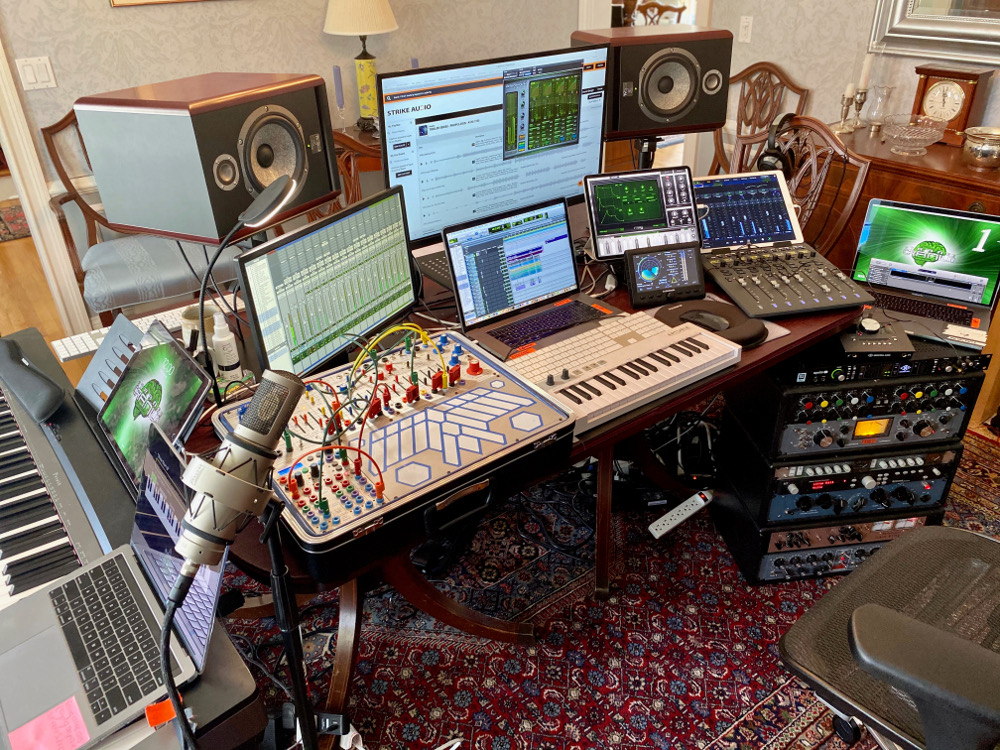
Stein’s first pass at a home-based setup sounded great, but was incompatible with a family space. (Photo by Billy Jay Stein)
“When the pandemic hit in March 2020, we moved up here full-time, as our daughters’ schools went fully remote,” continues Stein. “I set up my portable rig on the dining room table and continued to work on my projects for Strike Audio. After a few months of this my family couldn’t take it anymore—I guess they didn’t realize how many times they would have to hear me tune vocals and hear a “snare” sound over and over.”
Stein decided to level up in the Nutmeg State and craft a personal studio. “Having this spot would enable me to work whenever I’m in Connecticut,” he notes, “a complementary environment to the city space, a sort of ‘satellite’ if you will.”
For Stein, the goal was not to re-create the gear heaven that he had established with his Manhattan expanse. His CT space, a.k.a. Strange Cranium, is a complete 180 in ambiance.
“As you saw from my last SonicScoop article in 2017, my Manhattan spot is surrounded by gear,” he explains. “So, for this studio, I wanted to limit the gear ‘intrusion’ and try to create a more ZEN-like atmosphere. I wanted to create a smaller and select version of my NYC spot, incorporating my favorite and essential pieces of outboard gear and keyboards.
“That said, I also wanted the space to be able to grow over time, as I spend more time here and accumulate gear—which I tend to do!”
“A Phenomenal Concept”
Stein thought it was a long shot to get one of his all-time favorite studio designers on the project. But he contacted Manzella at his firm FM Design anyway, and got a surprise.
“Fran is a legend and I have loved working and recording in the rooms he designed in NYC for many years,” says Stein. “I have worked as session musician and engineer/producer at Stratosphere, Made Music, and The DiMenna Center. I also mastered many albums at Sterling Sound and Masterdisk.
“All those rooms always sounded fantastic and had a super great vibe. I called Fran on a whim, figuring he would be too busy to work on a small studio in Connecticut. But to my luck—during a very unlucky time—just as the pandemic hit, a couple of his projects were on hold, so he had time to work with me.”
According to Stein, Manzella was his trademark positive force as the project unfolded. “Fran was brilliant, easy-going, and super communicative. I sent him pictures of my raw basement space and we had several long Zoom meetings to talk about my goals and vision for the room.
“He came up with a phenomenal concept for the layout, vibe, and design. His challenge was to make the space with 8-foot ceilings feel ‘taller’ and more ‘spacious’ than it actually was. The ceiling concept he came up with was masterful and revolutionary.”
Strike Audio CT was off to a fabulous start. The project could have ground to a halt when Manzella died suddenly on August 16, 2020 due to complications from hip surgery, but the FM Design team refused to let that happen.
“When Fran passed away, all these designs and plans had been solidified except for the second recording vestibule area,” says Stein. “(FM Design Principal Designer) Greg Morris stepped in, and then Ken Capton from Solar2 and Matt Marinelli from Coral Sound did as well. As a team, with the help of [Fran’s wife] Doreen and the whole FM Design family, we finished the studio and fulfilled Frans’ vision for the space.”
Groovy Roomy
The 22-year old Cape Cod-style house was never intended to be anything remotely resembling a music studio. This gave the group many acoustical architecture puzzles to solve.
“The low ceiling height was a huge issue,” Stein says. “I am 6’3” and some of my collaborators are also very tall. Fran came up with the idea of creating fabric clouds of different depths, shapes, and sizes, with recessed multi-colored LED lighting to give the appearance of a ‘sky above us.’ It worked better than I could ever imagine! Besides looking cool and feeling serene, the room also sounds fantastic.
“Because we had all the home’s infrastructure located in the middle of the 800-square foot basement, we had to move some of the large units and ductwork around. There is very little natural light. However, there is one small window and Fran designed a beautiful angled, casing around it, so the room is quite bright now.”
Getting tuned-in collaborators was key to executing the room right, both for the present and the future.
“Fran recommended Matt Marinelli for Systems Design and Integration, as Fran had worked with Matt on many projects and thought we would be a good fit,” states Stein. “I sent Matt a list of all my gear—several pages worth—and we went through what would work for my space. I wanted the project to grow in phases over time. I also wanted the ability to easily swap out keyboards and outboard gear from the Manhattan studio to CT and vice versa.
“He and Fran came up a brilliant cable wiring concept: They designed a cable trough above the floor running along the side of the walls but appearing like it’s part of the wall. This allows for new cabling to be added as the space grows with minimal stress. It also keeps the floor from being floated in order to run cables, thus maximizing the height of the room.
“Matt also created custom-mounted, MIDI/analog remote patchbays, along the walls and just below the synths, so we can easily rotate different synths when needed. It is super flexible to patch and connect. Lastly, we created a custom desk and custom patchbay that is all normalled for my mix workflow.”
Likewise, Michigan-based studio specialist Ken Capton made a big impact with his fabric and cloud installations.
“Fran and Ken had worked together on many projects over the last 10 years, and the trust and admiration between them was incredible,” says Stein. “I was extremely lucky that Ken was available and on the East Coast during the fall to fulfill Frans’ vision. Ken followed Fran’s plans, prefabricated many of the fabric and wood panels in Detroit, and then tweaked the sizes of the clouds while onsite.
“It was like a ‘complex reverse puzzle installation’ and amazing to watch over 10 days. He also took Fran’s design concept further to create the ceiling clouds and custom panels for the vestibule, which acts as another recording room. After Ken finished his work here in November, he told me that his favorite part of the room is Frans’ design of the ceiling cloud.
Picking the Synths
Stein’s NYC studio supplied him with scores of synths and drum machines to compose with. In a Marie Kondo move he cut way down in his new space. But of course, this being Strike Audio, he had a plan of attack.
“I was determined to only bring 13 synths from among the 80+ plus available at the Manhattan location,” says Stein. “I wanted to split up the synths in a smart way—to have similar-type synths in both spots. I chose the Buchla Easel-K for Connecticut and kept the larger Buchla system in NYC. The Buchla’s are great for experimental soundscapes and just ‘un-natural craziness.’
“I kept the vintage MemoryMoog Plus in the city and a Moog One for the Connecticut spot. The Moog One sounds very similar to my original ‘80’s MemoryMoog, but has some modern bells and whistles like FX and more programming functions. I am having a blast working with it—it gives me instant inspiration!
“I brought up the Roland Jupiter 8, but kept the Juno 60 and MKS-80 Super Jupiter in the city. I love throwing the Jupiter 8 on pop tracks—nothing beats it. I took up the Teisco 110F and left the Kawai 100F. These little guys are like my secret analog weapons. They are super phat and unique. The producer Nick Littlemore (PNAU, Empire Of The Sun) turned me on to the 100F about 10 years ago, I found one in the Netherlands and it shipped here. I got the later model 110F a few years later.
“I brought up the ARP Quadra and ARP Odyssey—and left the ARP 2600 and ARP Pro Soloist in the city. What can one say about the ARPs? They are the best and instantly sound great. The other synths I brought up were The Dave Smith PolyEvolver, Korg PolySix, Korg MonoPoly, Arturia MatrixBrute, Oxford OSCar, Formanta Polivoks Russian synth, and Moog Grandmother. I think I have a nice representation of all things analog!
“As time progresses, I plan to bring up more synths from Manhattan. I think I’ll bring up the Oberheim 8 voice and Yamaha CS80 this summer. Because of the way we designed the Connecticut studio for maximum flexibility, this is an easy thing to do.”
Keeping these carefully curated keys company is ProTools HD, Logic Pro, Ableton Live, BitWig, and Strange Cranium MainBrainShow Control software. The hybrid analog/digital infrastructure incorporates Dangerous and Neve summing and monitoring, with ATC mains and Griffin Audio subs.
Fresh Focus
Strike Audio stayed busy as the relocation unfolded. In addition, Stein and his partner Michael Rosen helped support their colleagues in the creative community with GRAMMY and Emmy award-winning composer/orchestrator Jason Howland.
Their collaborations resulted in A Killer Party featuring 50+ Broadway professionals in a remote musical, “You’ve Got A Friend” in support of the Actor’s Fund, and producing/mixing the 2021 “Night of Stars” for the non-profit Covenant House featuring Sara Bareilles, Dolly Parton, Jon Bon Jovi, and Meryl Streep.
Such a radical switch in music production ecosystems can be a shock. But Stein sees how his minimalist environs have forced a welcome shift in his audio engineering habits.
“The new studio has given me a cleaner, fresher focus,” he observes. “The Connecticut studio is forcing me to use the ‘less is more’ concept in composing and mixing. I’m diving deeper into the tools I do have and finding new ways to get the desired results. Having less options is a good thing, but I do enjoy going back to the city and playing with more gear!”
This studio super-pro has a tip trio for emerging composers levelling up.
“Most breakthroughs come from years of experience,” Stein points out. “Rather than discuss a creative breakthrough, I think it’s just as important to comment on working with your collaborators. First off, you must have patience: Creative collaborations are a process and often it takes revision after revision to get to the final production.
“Secondly, the ability to listen. One has to listen carefully to collaborators. Trying to impose your own will on a project without fully considering the desires of others is a recipe for failure.
“Finally, and this seems obvious—try to have some fun. If you are not enjoying the work, the work will suffer.”
Meanwhile, Billy Jay Stein has learned things launching Strike Audio in a northern state.
“Have a vision. Be Patient. Take time and do it right from the start,” he reflects. “The loss of Fran was devasting for so many. I am truly thrilled, honored, and blessed to have a studio that he designed.”
— David Weiss is an Editor for SonicScoop.com, and has been covering pro audio developments for over 20 years. He is also the co-author of the music industry’s leading textbook on synch licensing, “Music Supervision, 2nd Edition: The Complete Guide to Selecting Music for Movies, TV, Games & New Media.” Email: david@sonicscoop.com
Please note: When you buy products through links on this page, we may earn an affiliate commission.







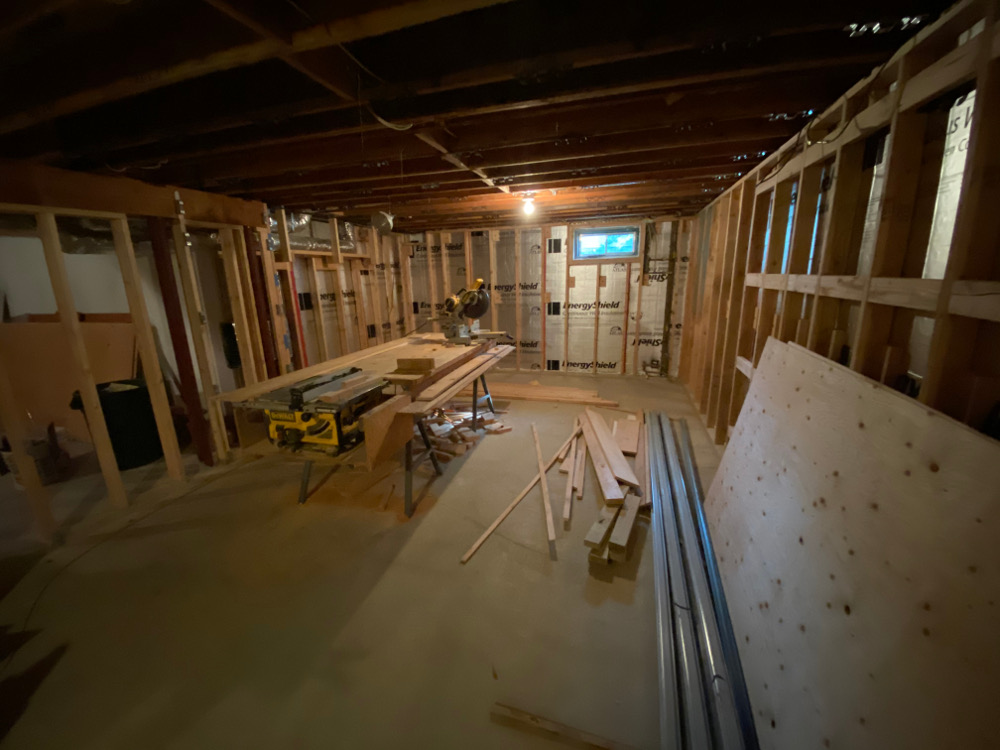
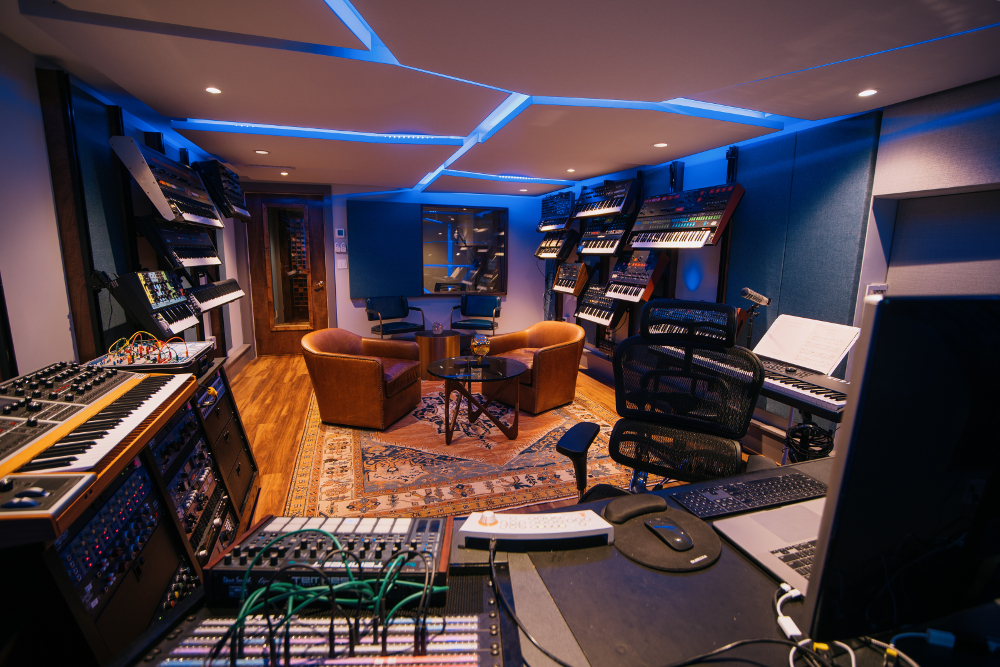
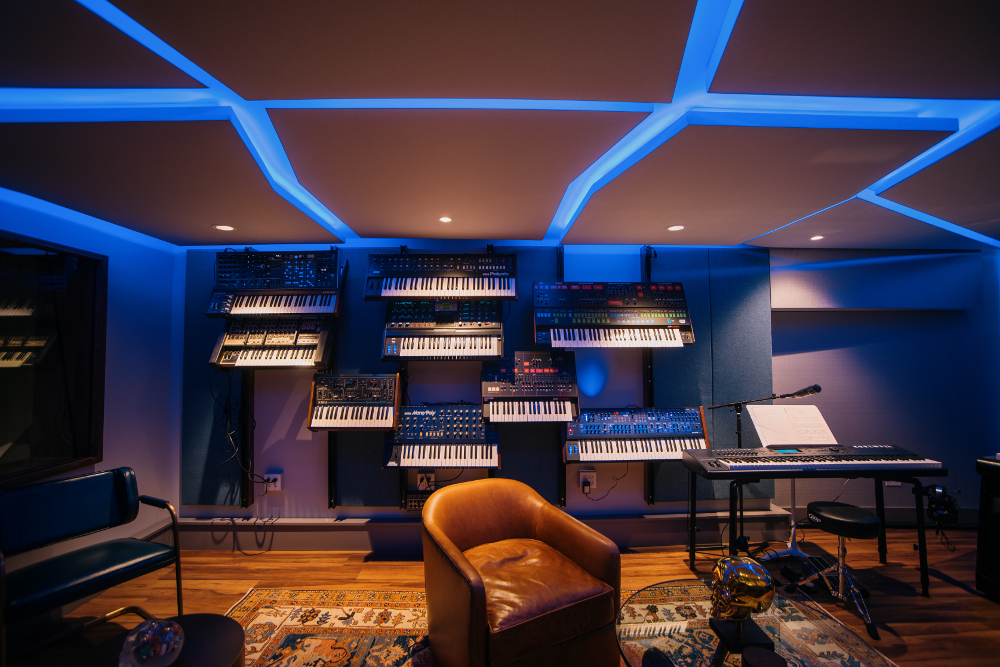
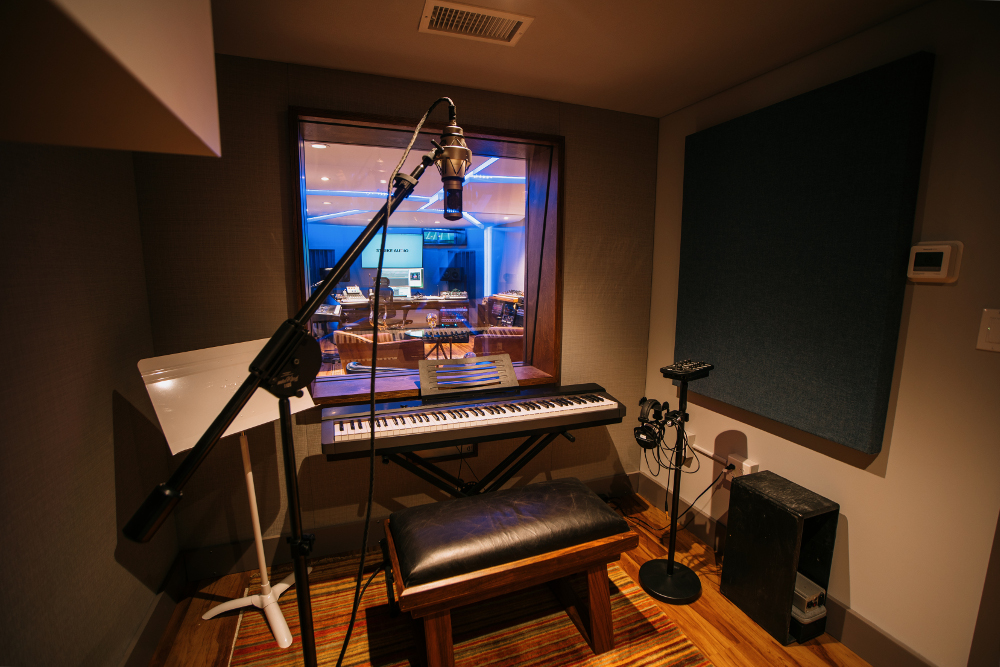
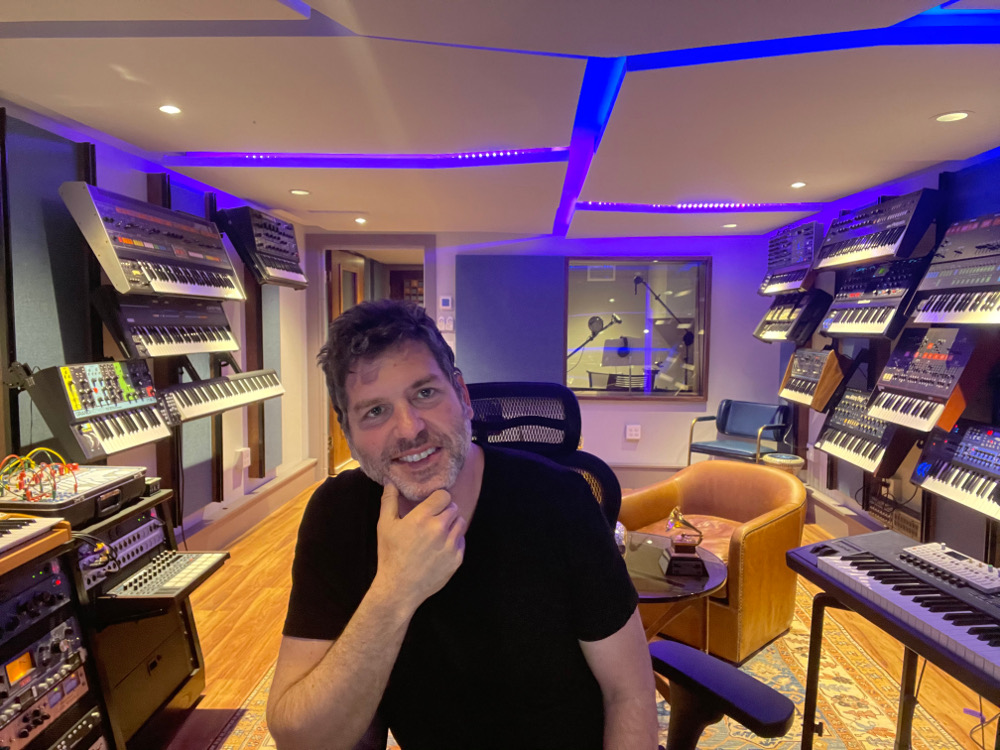
[…] Billy Jay Stein was. The GRAMMY-winning composer and partner in Strike Audio, a high-output TV/film/commercial music provider, was thrown for a loop by the pandemic—along with everyone else. But the global disruption motivated Stein to do more than write some new songs. It inspired Read more… […]